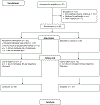Feasibility and Acceptability of a mHealth Self-Management Intervention for Pediatric Transplant Families
- PMID: 34154460
- PMCID: PMC8688578
- DOI: 10.1177/01939459211024656
Feasibility and Acceptability of a mHealth Self-Management Intervention for Pediatric Transplant Families
Abstract
Families of pediatric solid organ transplant recipients need ongoing education and support in the first 30 days following hospital discharge for the transplantation. The purpose of this report is to describe the feasibility, acceptability, and preliminary efficacy of a mHealth family-self management intervention, (myFAMI), designed to improve post-discharge outcomes of coping, family quality of life, self-efficacy, family self-management, and utilization of health care resources. We enrolled 46 primary family members. myFAMI was feasible and acceptable; 81% (n=17/21) of family members completed the app at least 24/30 days (goal 80% completion rate). Family members generated 134 trigger alerts and received a nurse response within the goal timeframe of < 2 h 99% of the time. Although there were no significant differences between groups, primary outcomes were in the expected direction. The intervention was well received and is feasible for future post-discharge interventions for families of children who receive an organ transplant.
Keywords: Discharge; Family; Pediatric; Self-management; Transplant.
Figures
References
-
- DeVito Dabbs A, Song MK, Myers BA, Li R, Hawkins RP, Pilewski JM, Bermudez CA, Aubrecht J, Begey A, Connoly M, Alrawashdeh M, & Dew MA (2016). A randomized controlled trial of a mobile health intervention to promote self-management after lung transplantation. American Journal of Transplantation, 16, 2172–2180. 10.1016/j.ijmedinfo.2016.07.012 - DOI - PMC - PubMed
Publication types
MeSH terms
Grants and funding
LinkOut - more resources
Full Text Sources
Medical


